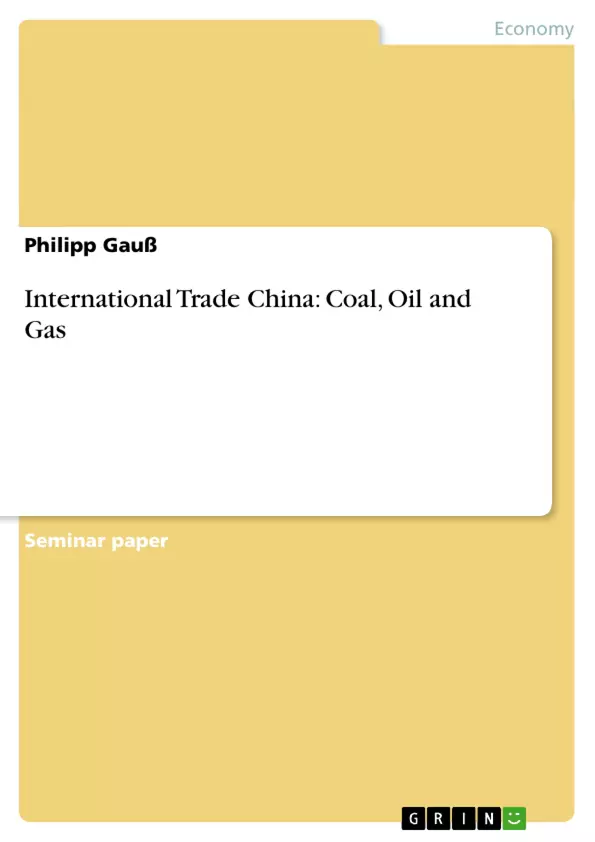China’s extremely fast growing economy has made the demand and supply of energy a crucial topic. Today, China is the largest consumer of primary energy and the third largest producer.
In the years between 1978 and 2000, the Chinese economy grew by 9% while at the same time the energy demand only grew by 4%. This trend has been turned around in 2001, when growth was stable at 9%, but energy demand grew by 13% a year.
While China demanded 10% of the world energy demand in 2001, supporting these demand by 96% of domestic production, in 2007 they already accounted for 15% of the worlds energy demand, making them dependent on imports for coal, oil and gas,
due to domestic supply lower 90%.
As a result of these movements in the domestic demand and production picture of primary energies, China will have to face growing dependencies on the international energy markets, to secure sufficient energy to industry and population.
The purpose of this paper is to show the change of trade flows in China with a focus on the primary energy resource coal, oil and gas. The change of production, consumption,import and export of these as well as related topics as price and transportation
will be identified.Illustrating government involvements and economic players will complete the research
to offer a comprehensive picture.
[...]
Inhaltsverzeichnis (Table of Contents)
- Introduction
- Facts and Figures
- Coal
- Production and Consumption
- Export and Imports
- Reserves and Resources
- Regions
- Price
- Transportation
- Oil
- Production and Consumption
- Export and Imports
- Reserves and Resources
- Regions
- Price
- Transportation
- Railway
- Domestic Pipelines
- Transnational Pipelines
- Ship
- Gas
- Production and Consumption
- Export and Imports
- Reserves and Resources
- Regions
- Price
- Transport
- Domestic Pipelines
- Transnational Pipelines
- Politics
- Coal
- Oil
- Gas
- Regulations
- WTO
- Free Trade Agreements
- Important acquisitions and cooperation's
- International Trade Conflicts
- Companies
- Sinopec
- CNPC
- China Shenhua Energy Company Limited
Zielsetzung und Themenschwerpunkte (Objectives and Key Themes)
This paper aims to provide a comprehensive overview of the flow of trade for coal, oil, and gas in China. It examines the production, consumption, export, and import of these resources, as well as their reserves and resources. The paper also discusses the key regions involved in these industries, the prices of these commodities, and the transportation infrastructure used to move them. Additionally, it explores the political landscape surrounding the trade of coal, oil, and gas in China, including regulations, international agreements, and conflicts.- The production, consumption, and trade of coal, oil, and gas in China.
- The role of transportation infrastructure in facilitating these trades.
- The political and economic factors influencing trade.
- The key companies involved in the production and distribution of these resources.
- The challenges and opportunities facing China's energy sector.
Zusammenfassung der Kapitel (Chapter Summaries)
The "Introduction" chapter lays the groundwork for the paper, outlining the importance of China's energy sector and highlighting the significance of coal, oil, and gas in the country's economy. The "Facts and Figures" chapter provides a general overview of the Chinese energy industry, encompassing details about production, consumption, and overall energy mix. The "Coal" chapter dives into the details of China's coal industry, encompassing production, consumption, exports, imports, reserves, resources, regions, pricing, and transportation. The "Oil" chapter follows a similar structure, delving into the production, consumption, export, and import of oil, along with reserves, resources, regions, pricing, and transportation. This chapter also analyzes the different modes of transportation used for oil, including railways, domestic pipelines, transnational pipelines, and shipping. The "Gas" chapter mirrors the format of the previous chapters by examining the production, consumption, exports, imports, reserves, resources, regions, pricing, and transportation of natural gas. This chapter further explores the specific modes of transportation used for gas, namely domestic pipelines and transnational pipelines. The "Politics" chapter analyzes the political landscape surrounding the trade of coal, oil, and gas in China. It discusses regulations, the World Trade Organization (WTO), free trade agreements, major acquisitions and collaborations, and international trade conflicts. The "Companies" chapter delves into the prominent companies involved in the production and distribution of coal, oil, and gas in China, namely Sinopec, CNPC, and China Shenhua Energy Company Limited.Schlüsselwörter (Keywords)
The key terms and focus topics of this work center around China's energy sector, particularly the flow of trade for coal, oil, and gas. The paper investigates the production, consumption, exports, imports, reserves, and resources of these crucial energy sources. Furthermore, it delves into the various regions involved in these industries, the price dynamics of these commodities, and the transportation infrastructure utilized for their movement.- Citation du texte
- Philipp Gauß (Auteur), 2009, International Trade China: Coal, Oil and Gas, Munich, GRIN Verlag, https://www.grin.com/document/138061



